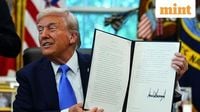On September 19, 2025, the Trump administration sent shockwaves through the global technology sector by announcing a dramatic increase in the one-time H-1B visa fee for new applicants. The cost soared to $100,000, a staggering leap from the previous range of $2,000 to $5,000, depending on the size of the sponsoring company, according to multiple reports including Reuters and BBC. The White House clarified a day later that this fee would apply only to new applications, and would be a one-time charge. Still, the announcement triggered immediate chaos and uncertainty across both the United States and the countries most reliant on the H-1B program.
The H-1B visa, originally introduced to fill skill gaps in the U.S. workforce, has long been a lifeline for American technology companies and a critical avenue for skilled professionals from around the globe—especially from India and China. As per U.S. government data cited by BBC, India accounted for 71% of all approved H-1B applications last year, with China as a distant second at 11.7%. For India’s $283 billion IT sector, which earns about 57% of its revenue from the U.S., the fee hike is nothing short of seismic.
The immediate fallout was dramatic. Silicon Valley giants warned their employees against traveling abroad, foreign workers scrambled to book return flights, and immigration lawyers worked overtime to interpret the new rules. According to Reuters, tech veterans and economists warned that the $100,000 fee would disrupt the long-standing practice of rotating skilled talent into U.S.-based projects. Companies such as Apple, JPMorgan Chase, Walmart, Microsoft, Meta, and Alphabet’s Google—frequent clients of Indian IT firms—are now expected to pause onshore rotations, accelerate offshore project delivery, and ramp up hiring of U.S. citizens.
Indian outsourcing giants such as Tata Consultancy Services (TCS) and Infosys have already begun adapting to the new reality. According to BBC, these companies are building local workforces in the U.S. and shifting more of their project delivery offshore. Aditya Narayan Mishra, CEO of CIEL HR, a leading staffing firm, told BBC, “With employers reluctant to commit to the heavy cost of sponsorship, we could see greater reliance on remote contracting, offshore delivery and gig workers.”
For Indian IT and IT-enabled services (ITes), the change is particularly jarring. These sectors have enjoyed a compound annual growth rate of 12.1% over the last three decades, much of it fueled by business from the U.S. The H-1B program allowed Indian professionals to work closely with American clients, ensuring smooth project execution and fostering innovation. Now, with the new fee structure, many companies may be forced to reconsider their hiring and project management strategies.
The ramifications, however, extend far beyond India and China. Experts warn that the fee hike could have unintended consequences for American innovation and competitiveness. Gil Guerra, an immigration policy analyst, explained, “The demand for new workers in fields like tech and medicine [in US] is projected to increase (albeit in uneven ways), and given how specialised and critical these fields are, a shortage that lasts even a few years could have a serious impact on the US economy and national well-being.” In other words, if American companies cannot access the global talent they need, the entire economy could feel the pinch.
Indeed, the uncertainty surrounding the future of the H-1B program is palpable. The program has faced criticism in recent years for allegedly undercutting American workers, but it has also been praised for bringing in top global talent. Now, with the $100,000 price tag, many U.S. employers may be forced to radically change their talent acquisition strategies. The likely outcome, as several analysts have noted, is a greater reliance on remote workers, gig economy professionals, and offshore teams—potentially undermining the collaborative spirit that has driven American tech innovation for decades.
But the story doesn’t end there. The ripple effects of the fee hike are already being felt in the international education sector. With the U.S. becoming a less attractive destination for skilled immigrants, more international students from India and China are expected to consider alternative destinations for study and work. This shift could have a profound impact on the American university system, which relies heavily on tuition from foreign students—many of whom hope to stay in the U.S. and work after graduation.
Other countries are wasting no time in seizing the opportunity. According to BBC, Canada is positioning itself as a prime destination for global tech talent, thanks to its strategic location and more welcoming immigration policies. The United Kingdom’s “Global Talent Task Force” is actively working to lure top scientists, academics, and digital experts, while Germany has openly invited H-1B visa holders to seek employment there. The message is clear: in the new global race for talent, the U.S. may be ceding ground to its competitors.
For now, the mood in the U.S. tech industry is one of anxiety and adaptation. Companies are scrambling to understand the long-term implications of the fee hike, while workers—both American and foreign—are left wondering how the changes will affect their careers and livelihoods. Some U.S. firms may benefit in the short term from increased hiring of domestic workers, but the broader consensus among industry leaders is that the loss of global talent could ultimately hinder innovation and economic growth.
Meanwhile, the political debate over skilled immigration shows no signs of abating. Supporters of the fee hike argue it will protect American jobs and encourage companies to invest in domestic talent. Critics, however, warn that such measures risk isolating the U.S. from the global marketplace and eroding its leadership in technology and research. The coming months will reveal whether the new policy achieves its intended goals or whether it triggers a lasting shift in the global flow of talent and capital.
As the dust settles, one thing is certain: the $100,000 H-1B visa fee has upended decades of established practice, forcing companies, workers, and policymakers alike to rethink their strategies in an increasingly interconnected world.




